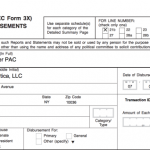This Candidate For Congress Will Let His Constituents Decide How He Votes
Michael Allman is running for Congress as a Republican. But if his constituents lean left of him on a particular issue before Congress, that’s how Allman will vote. That’s because Allman is running on a direct democracy platform: For every issue, voters in his district will be able to use a blockchain-enabled website to securely log their opinions, and Allman will follow the will of the people.
“Everyone thinks what’s happening in Washington, D.C., today is broken,” says Allman, former CEO of Southern California Gas, who is running for the 52nd district in San Diego County. “Nobody thinks it’s working. We can go into a hundred reasons why, but I’d summarize it with just one word: Partisanship. Everybody votes with the party on pretty much everything, and it’s a red versus blue, us versus them kind of attitude.”

Allman has no background in politics, but has worked in the tech industry, and realized that the technology exists to make direct representation possible. Working with a tech company that had an existing platform, he created a custom website that will outline both sides of a general issue–for example, whether or not there should be more gun control laws–or a specific bill. Voters can read through the arguments on both sides, and read selected op-eds. The site can verify that someone is in a particular district and that they’re registered to vote, and then register their opinion confidentially.
Of course, the success of the system will depend on participation–and even elections typically have low turnout (for midterm elections, turnout is only around 40%). But logging on to the online platform is easier than making it to a polling place, and for ongoing issues, people won’t have to vote by a particular deadline. Conceivably, if voters know that their participation could make a difference on an actual vote in Congress–and that impact is guaranteed, rather than making calls or sending emails to representatives–they may be more motivated to act.
“What I’ve heard is that people want to be engaged, they just don’t know how,” Allman says. “I think Trump did everybody a favor, if you will, last election, in that everybody’s got an opinion now. They want to be engaged. The polling I’m showing is clear on that. They just don’t know what to do.”
Allman plans to reach out to both constituents and advocacy groups to encourage participation. He envisions that if the votes on an issue are leaning in one direction, lobbyists will bring their money directly to his district, rather than pressuring him as the representative. “I think of that as a positive change, if we can bring that money out of Washington,” he says. But he admits that sustaining voter participation will be the platform’s biggest challenge.
Winning the election against the incumbent, Democrat Scott Peters, will also be a challenge: Peters won in 2016 with nearly 60% of the vote. Allman is the first candidate for the House of Representatives to run on this type of platform. Others running elsewhere, like candidates who ran on a similar platform in Australia earlier this year, haven’t been successful. And though some Democrats have told Allman that they won’t consider supporting him because of his party affiliation, around 30% of voters in the district are registered as independents.
“I think they will determine the election,” Allman says. “They have the last time, because the reality is 95% of the Democrats are going to vote Democrat. Ninety-five percent of the Republicans are going to vote Republican . . . Last time, they broke 55-45 Democrats; I think with my platform with voting with the people by issues, I’ll get 55 or better the other way.”
Allman also hopes to share the technology with other politicians; two sitting state assemblymembers have already approached him. “I spent a fair amount of coin doing it and I can provide it to anybody who wants it at well below cost,” he says. “It supports a cause that I believe in. So I hope that a bunch of people pick up on this and at least get more engaged with their constituents–if not go as far as I am to agree to vote with them.”
Fast Company , Read Full Story
(11)














